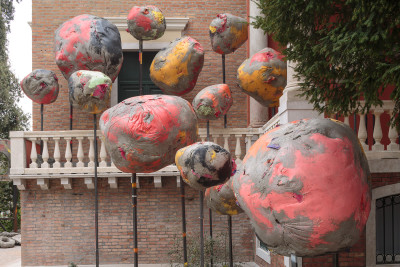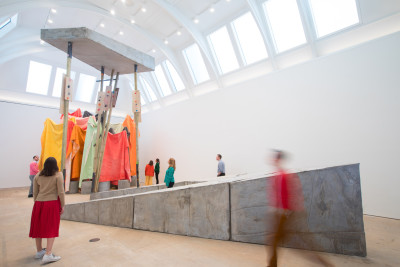Four things to know about Phyllida Barlow’s sculpture
Four things to know about Phyllida Barlow’s sculpture
By Jon Wood
Published 4 March 2019
As the Academician’s site-specific show opens at the RA, Jon Wood explains what we gain from the pleasures and perplexities of her works.
-
From the Spring 2019 issue of RA Magazine, issued quarterly to Friends of the RA.
1. Phyllida Barlow’s sculpture wears its heart on its sleeve
While informed by the artist’s awareness of modern sculpture and its histories, Barlow’s work also strives to give fresh experiences – both to herself as an artist and her viewers. She is determined to start from scratch each time as she allows one work to carry forward into the next. Her series of installations in the RA’s Gabrielle Jungels-Winkler Galleries are under wraps until late February, but in past exhibitions we faced a precariously balanced tower that looked as if it might topple over, for example, or found ourselves at the threshold of a room we could not really enter because it was too stuffed with stuff.
2. Her work aims to unsettle rather than comfort
She stages awkward and puzzling ensembles that ask us to look hard at what is before us and to take stock of our bearings in relation to them. The wonderfully messy and complex material life of her sculpture is crucial to this. Gone is the smooth surface argumentation of cast bronze or plaster. Polish, shine and sheen are exchanged for matte and rough surface, as wood, cement, fabric, paint and other mixed media, all compete for our attention in variously fabricated forms. We think about what values the visual and material qualities of her works evoke. Our bodies – also with their complex blends of hard and soft, tidy and messy – are quietly appealed to by the sculpture, and we are drawn into such experiences physically.
-

Phyllida Barlow, folly, 2017.

View of the exhibition, Phyllida Barlow RA cul-de-sac

View of the exhibition, Phyllida Barlow RA cul-de-sac
-
3. Asymmetries and imperfections are all
The viewer’s imagination is harnessed to think of sculpture, although static, as alive and kicking, full of possibility and still potentially unfinished and unresolved. The beauty and simplicity of the sphere as a primary form has long haunted the modern sculptural imagination. Barlow’s spheres are anti-spheres: fantastic globular objects that read as boulders as much as globes – evoking the prehistoric dwelling as much as the mythological Atlas (folly, 2017; above). Such works also set up challenging relations with photography, questioning our ideas about what makes something photogenic – or not – and what works compositionally for the camera.
4. We take them personally
Her sculptures are head- and hand-made human creations: we pay personal attention to their clumsy, rough-and-tumble energy and their restless generosity of spirit. Big and bold and flashed with colour, they grab our gaze but also make room for us to make them our own, inviting our imaginations in, rather than shutting them out.
After an exhibition by Phyllida Barlow, we step out onto the street to see the material conditions of the world around us slightly differently. We might question the logic of pre-formatted material, rethink the charm of cast concrete, or recalibrate our sense of frailty beneath an imposing glass-fronted building. Whatever our particular response, the experience of Barlow’s work continues beyond the exhibition walls and subtly informs the way in which we see the world around us.
-
In the studio with Phyllida Barlow RA
In this extract from the forthcoming documentary film Phyllida, Phyllida Barlow talks about her approach to sculpture and the role of chance in her work.
-
Jon Wood is a writer and curator.
-
-

Phyllida Barlow RA cul-de-sac
23 February – 23 June
Acclaimed British sculptor Phyllida Barlow RA takes over our contemporary galleries with large-scale new works – made with her signature everyday and industrial materials.
Towering above like seemingly precarious structures, these site-specific works both test and take inspiration from the gallery’s architecture. In the form of a cul-de-sac, with only one way in and out, it gives visitors the freedom to find their way between them.
Lead support by Art Fund
-
-

Phyllida Barlow, folly, 2017.
Installation view, British Pavilion, 57th Venice Biennale.
Courtesy the artist and Hauser & Wirth © British Council. Photo: Ruth Clark.








